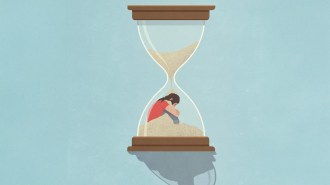In PTSD, a good night’s sleep means feeling safe
Learning a safety signal in a shock paradigm associated with a better night’s sleep

Many people diagnosed with PTSD suffer from problems with getting a good night's sleep. A new study shows that in these patients, sleep problems aren’t linked to reaction to fear, but instead to a sense of safety.
Sergey Goyshik/Shutterstock
- More than 2 years ago
Post-traumatic stress disorder, or PTSD, has many different symptoms. Patients may suffer from anxiety, flashbacks, memory problems and a host of other reactions to a traumatic event. But one symptom is especially common: 70 percent of civilian patients and 90 percent of combat veterans with PTSD just can’t get a decent night’s sleep.
Problems with sleep, including rapid-eye movement — or REM — sleep, have long been associated with PTSD. “We know that sleep difficulties in the weeks following trauma predict the development of PTSD, and we know that bad sleep makes PTSD symptoms worse,” says Sean Drummond, a clinical psychologist who studies sleep at the University of California at San Diego. Studies in rats show that exposing the animals to traumatic, fearful experiences such as foot shocks disrupts their REM sleep. Drummond and his research assistant Anisa Marshall wanted to connect those findings to humans. But he soon found out that in humans, it’s not fear that predicts REM sleep. Instead, it’s safety.
The scientists tested this in 42 people without PTSD using a measure called fear-potentiated startle. Subjects sit in a comfortable chair with an electrode on their wrists. A screen shows blue squares or yellow squares. If participants see blue squares, they run a high risk of receiving an annoying shock to the wrist. If they see yellow squares, they can relax; no shocks are headed their way. During this time, they will also hear random, loud bursts of white noise. The scientists measure how much the subjects startle in response to the noise by measuring the strength of their eyeblinks in response to the noise. In the presence of the blue squares, the blinks become much stronger, an effect called fear-potentiated startle. With yellow squares, the blinks weaken.
In a study published August 27 in the Journal of Neuroscience, Marshall, Drummond and colleagues hypothesized that, like rats, people with high startle responses would have poorer REM sleep, with more interruptions and waking. They were surprised to find no significant effect of a high startle response on REM sleep. Instead, the subjects’ response to safety was the important factor: People who had relaxed the most in the presence of the safe yellow squares slept the best.
And a good night’s sleep paid off. The next day, the subjects saw the yellow and blue squares again. This time, they received no shocks. Those with improved REM sleep were better able to remember the difference between safety and danger signals (again, as measured by eyeblinks).
Many previous studies of PTSD have focused on fear and trauma, but none have focused on a sense of safety. Suzanne Diekelmann, a psychologist at the University of Tübingen in Germany, says that the study shows “the ability to learn that certain signals or environments are safe, and particularly the ability to discriminate between threat and safety, might be more important than previously thought.”
Drummond says the results indicate that sleep treatment might be as important to PTSD as other treatments, such as extinction therapy, in which patients are exposed to a traumatic experience in a safe environment until they learn that the traumatic experience can no longer harm them. “It suggests that people who have PTSD [and a sleep disorder] may not do well in extinction therapy,” he says. “Perhaps what we should be doing is treating sleep before we treat PTSD.”
Studying extinction and REM sleep in this way will be the next step, suggests Edward Pace-Schott, a behavioral neuroscientist at Harvard. If patients who learn a safety signal more effectively have a better night’s sleep, it could help them perform better when trying to extinguish traumatic memories.







